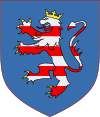Edmund, Duke of Lolland (Merveilles des Morte)
| Edmund, Duke of Lolland | |
|---|---|
 Portrait by Gregor Altdorfer, 1529 | |
| Duke of Lolland | |
| Reign | 1502- |
| Predecessor | Title Created |
| Successor | Henry I |
| Born |
10 July 1487 Weimar, Thuringia, Holy Roman Empire |
| Died |
17 May 1542 Maribo, Lolland, Denmark |
| Spouse | Henriette Ingeborg of Denmark |
| Issue |
|
| House | House of Jenagotha |
| Father | Wolfgang |
| Mother | Louise de la Marck |
| Religion | Jungism (1521-) |
Edmund I (10 July 1487 - 17 May 1542) was a Thuringian nobleman who ruled as Duke of Lolland from 1502 to his death. Edmund was a grandson of the Thin White Duke and the son of famous adventurer and author Wolfgang the Wanderer and Louise de la Marck of Saxony. Edmund was named in honor of Wolfgang's close companion Edmund Alwin, who later became Duke of Saxony. Wolfgang had married Edmund Alwin's sister, while Edmund Alwin had married Wolfgang's, naming his first son Wolfgang in a similar gesture.
In 1491 Henry I ascended to the throne of Denmark, placing the House of Marck in command of the country following Henry's marriage to the only daughter of King Otto III. A number of Saxon noblemen and relatives would be placed in positions of power in Denmark, Edmund I being one of them, his brother-in-law Andres Heinrich of Halland being another. As Duke of Lolland, Edmund relocated to Denmark and spent the rest of his life there. When the Protestant Reformation reached the country in the late 1510s Edmund was an early sympathizer, formally converting to Jungism in 1521. He supported war against Norway and advocated for closer ties to Sweden and Charles I of Brandenburg. In 1524 Edmund became heavily invested in the wars of religion in Scandinavia, sending a mercenary army to rendezvous with Jungist leader Nils Stenbock in Sweden. By the time of his death in 1542 both Denmark and Sweden had firmly adopted the Jungist religion, although hopes of the two nations' continued cooperation were dashed soon after, culminating in the Eight Years' War.

